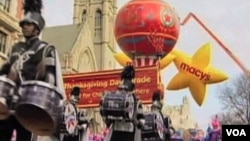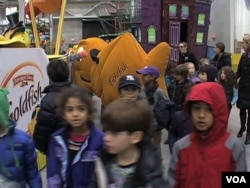NEW YORK —
Hundreds of clowns, marching bands, elaborate floats and giant balloon characters hovering overhead have kicked off the winter holidays in New York City almost every year since 1924, when Macy’s Department Store held its first Thanksgiving Day parade.
It has been canceled only twice, during World War II, when rubber and helium were needed for the war effort.
Over the years, the parade has become a multimillion-dollar, Hollywood-scale production, with dozens of employees working out of a hangar-size studio in New Jersey year-round, designing, fabricating and refurbishing balloons, floats and costumes.
This year, the 86th annual parade will include 28 floats, six of them new, and 16 giant balloons, including three new ones.
More than 8,000 people take part in the parade each year, said parade executive producer Amy Kule, including singers, dancers, cheerleaders, balloon-handlers and clowns - many of them Macy’s employees who volunteer
Kule showed off some of the new floats at a preview for media and schoolchildren. Most are supported by companies or organizations promoting their brands on floats seen by several million parade-goers in New York, and an estimated 50 million who watch it live on television.
A food company, Pepperidge Farm, for example, has a new float in the form of a pop-up book, featuring its "Goldfish" crackers brand.
“There’s a great back story," Kule said, "with goldfish living under a young boy’s bed, who have decided to create their own Macy’s parade float with found objects: puzzle pieces, game pieces, paper clips, pencils, straws."
Another float, for Domino Sugar, looks like a bit like a huge, candy-colored model train set. It’s topped with a giant mixing bowl “being stirred by our 16-foot-high [3-meter] wooden spoon,” said John Piper, vice-president of Macy’s Parade Studio.
“It comes out of the spout and goes into the cookie press, and the cookie press will drop down dollops of cookie onto the turntable that goes onto the cookie-express oven,” he said. “From there, the treats will come down the chute and be loaded into the train cars that are waiting. The kids are actually going to be dressed as gingerbread men and girls and chocolate chip cookies, and they’ll be riding in the train cars as holiday treats.”
Piper explained some of the special vocabulary that the Parade designers use. “You’ve got a float, you’ve got a balloon, and we’ve got a few where we mix them together: Put an inflatable on a rolling unit, and that’s a ‘falloon,’” he said.
“Now, the balloons are marched down the parade route by people holding onto the lines. But we have a couple of them that can come down the parade route on their own, because they’ve got a secret vehicle. That’s a ‘balloonicle.’And last year, we had a brand new [creation], a ‘trycaloon.’ That’s where you have a tandem tricycle that’s pedaled in front by a person in costume, and ‘pedaled’ in back by a balloon.”
Amy Kule and 200 volunteers turned out to a field in suburban New Jersey in early November to help test three new giant balloon characters: Papa Smurf, Elf on the Shelf, and Hello Kitty, piloting an airplane.
“Each one of the balloon-handlers in the Macy's Thanksgiving Day Parade goes through weeks of training,” Kule said. “They've got to understand the aerodynamics of the balloon; we've got to make sure they're physically fit. And under each one of these balloons, we can have up to 70 people.”
The balloon-handlers are not the only parade participants who must be trained. Volunteer clowns, many of them Macy’s employees, take lessons from the Big Apple Circus, Kule said. “Each of our clowns goes and learns to be silly, learns to have a good time, learns how to throw confetti, and how to interact with the audience,” she said.
The night before the parade, the floats travel in a convoy from New Jersey to New York through the Lincoln Tunnel - an impossible fit at their size, Piper said, since some are 18 meters tall and ten meters wide. So, each float is built so it can be dismantled into pieces no more than four meters tall and about 2.5 meters wide.
“Similarly, all the balloons are inflated the day before,” Piper said. “We close the streets on the Upper West Side at about 10 a.m., lay down tarps from one end of the street to the other, unroll the balloons and cover them with nets, put sandbags around the outside, and start flowing the helium into them, so they’re completely filled by Wednesday evening."
“Then they stay overnight on 77th and 81st street," he went on. "And even before the sun rises, the team comes back out and pumps a little more helium into them, just to get them ready for the parade.”
“On Parade Day, I’ve got the easiest job in the world,” Kule said. It begins by calling out a phrase trademarked by Macy’s: “Let’s have a parade!” Then she cuts the ribbon and leads the procession as it heads down Central Park West and over to Sixth Avenue.
Kule would not say how much Macy’s spends on the parade. But from the parade's beginnings, she said, “It was really the employees coming together with a desire to entertain. And that has not changed. Everyone who participates has this sense of joy, this sense of pride with what they’re producing. And we owe it to America to produce this parade and bring that sense of joy to the holidays.”
It has been canceled only twice, during World War II, when rubber and helium were needed for the war effort.
Over the years, the parade has become a multimillion-dollar, Hollywood-scale production, with dozens of employees working out of a hangar-size studio in New Jersey year-round, designing, fabricating and refurbishing balloons, floats and costumes.
This year, the 86th annual parade will include 28 floats, six of them new, and 16 giant balloons, including three new ones.
More than 8,000 people take part in the parade each year, said parade executive producer Amy Kule, including singers, dancers, cheerleaders, balloon-handlers and clowns - many of them Macy’s employees who volunteer
Kule showed off some of the new floats at a preview for media and schoolchildren. Most are supported by companies or organizations promoting their brands on floats seen by several million parade-goers in New York, and an estimated 50 million who watch it live on television.
A food company, Pepperidge Farm, for example, has a new float in the form of a pop-up book, featuring its "Goldfish" crackers brand.
“There’s a great back story," Kule said, "with goldfish living under a young boy’s bed, who have decided to create their own Macy’s parade float with found objects: puzzle pieces, game pieces, paper clips, pencils, straws."
Another float, for Domino Sugar, looks like a bit like a huge, candy-colored model train set. It’s topped with a giant mixing bowl “being stirred by our 16-foot-high [3-meter] wooden spoon,” said John Piper, vice-president of Macy’s Parade Studio.
“It comes out of the spout and goes into the cookie press, and the cookie press will drop down dollops of cookie onto the turntable that goes onto the cookie-express oven,” he said. “From there, the treats will come down the chute and be loaded into the train cars that are waiting. The kids are actually going to be dressed as gingerbread men and girls and chocolate chip cookies, and they’ll be riding in the train cars as holiday treats.”
Piper explained some of the special vocabulary that the Parade designers use. “You’ve got a float, you’ve got a balloon, and we’ve got a few where we mix them together: Put an inflatable on a rolling unit, and that’s a ‘falloon,’” he said.
“Now, the balloons are marched down the parade route by people holding onto the lines. But we have a couple of them that can come down the parade route on their own, because they’ve got a secret vehicle. That’s a ‘balloonicle.’And last year, we had a brand new [creation], a ‘trycaloon.’ That’s where you have a tandem tricycle that’s pedaled in front by a person in costume, and ‘pedaled’ in back by a balloon.”
Amy Kule and 200 volunteers turned out to a field in suburban New Jersey in early November to help test three new giant balloon characters: Papa Smurf, Elf on the Shelf, and Hello Kitty, piloting an airplane.
“Each one of the balloon-handlers in the Macy's Thanksgiving Day Parade goes through weeks of training,” Kule said. “They've got to understand the aerodynamics of the balloon; we've got to make sure they're physically fit. And under each one of these balloons, we can have up to 70 people.”
The balloon-handlers are not the only parade participants who must be trained. Volunteer clowns, many of them Macy’s employees, take lessons from the Big Apple Circus, Kule said. “Each of our clowns goes and learns to be silly, learns to have a good time, learns how to throw confetti, and how to interact with the audience,” she said.
The night before the parade, the floats travel in a convoy from New Jersey to New York through the Lincoln Tunnel - an impossible fit at their size, Piper said, since some are 18 meters tall and ten meters wide. So, each float is built so it can be dismantled into pieces no more than four meters tall and about 2.5 meters wide.
“Similarly, all the balloons are inflated the day before,” Piper said. “We close the streets on the Upper West Side at about 10 a.m., lay down tarps from one end of the street to the other, unroll the balloons and cover them with nets, put sandbags around the outside, and start flowing the helium into them, so they’re completely filled by Wednesday evening."
“Then they stay overnight on 77th and 81st street," he went on. "And even before the sun rises, the team comes back out and pumps a little more helium into them, just to get them ready for the parade.”
“On Parade Day, I’ve got the easiest job in the world,” Kule said. It begins by calling out a phrase trademarked by Macy’s: “Let’s have a parade!” Then she cuts the ribbon and leads the procession as it heads down Central Park West and over to Sixth Avenue.
Kule would not say how much Macy’s spends on the parade. But from the parade's beginnings, she said, “It was really the employees coming together with a desire to entertain. And that has not changed. Everyone who participates has this sense of joy, this sense of pride with what they’re producing. And we owe it to America to produce this parade and bring that sense of joy to the holidays.”








